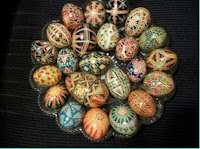Eggs have been decorated for centuries. The early Christians of Mesopotamia were already coloring eggs by staining them. It was in 1610 A.D. that the Christian Church officially adopted the custom. What did they do prior to the availability of food coloring?
In today's world Easter eggs are largely decorated by children with the help of a parent. We purchased "fizzy" coloring which is a tablet that is placed in cold water. We add the boiled egg and after a while take it out and the shell is colored. Prior to this there were tablets which were place in extremely hot water with a teaspoon of vinegar. Again we added the boiled egg, waited a bit and soon had a beautifully colored egg. When I was a child we just used bottled food coloring, a messy alternative but we obtained the same results.
Prior to the food coloring we know today, eggs were colored with natural dyes. Red wine results in a violet blue egg, blueberries a blue one of course. Would you like a green egg? Try boiled spinach leaves. Yellow? Boiled orange ore lemon peels should do the trick. Boiled yellow onion skins will give you a shade of orange or peach. Like pink eggs, try beets. The list goes on and it is fun to try different and unique natural dyes. Even strong coffee will dye eggs a brown! Think of what will stain your clothes and you know of something that will dye eggs naturally.
I did title this the Easter Eggs of Poland. In our ancestors time the coloring of eggs would use many of the same dyes we term natural today. It is all they had but they used dyes, wax, paper and sometimes straw in different ways.
In
Poland
The Easter eggs of Poland usually fall into five types:
Kraszanki
– hard boiled and made for eating, these are dyed one color only (these are our basic Easter eggs)
Malowanki
– blown egg with a colored design painted on the top (this type is also made in Russia but I am sure they have a different name)
Pisanki
– blown egg made by applying various wax patterns (sometimes known as the
Ukrainian Easter egg)
Okeljane
or nalepianki – blown egg decorated with paper or straw
Skrobanki – blown egg that is scratch carved





No comments:
Post a Comment